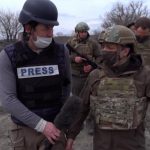Wildlife Is Now Thriving Again in Chernobyl–Even If Humans Won’t for Another 24,000 Years
In Andrei Tarkovsky’s 1979 sci-fi film Stalker, a mysterious artifact renders a landscape called the Zone inhospitable for humans. As critics have often pointed out, a tragic irony may have killed the director and some of the crew a few years later. Shooting for months on end in a disused refinery in Estonia exposed them to high levels of toxic chemicals. Tarkovsky died of cancer in 1986, just a few months after the disaster at Chernobyl. “It is surely part of Stalker’s mystique,” Mark Le Fanu writes for Criterion, “that in some strange way, Tarkovsky’s explorations … were to ‘prophesy’ the destruction… of the nuclear power plant.”
Tarkovsky did not see the future. He adapted a dystopian story written by brothers Arkady and Boris Strugatsky. “Certainly,” writes Le Fanu, “there were many things in the Soviet Union at that time to be dystopian about.” But the film inspired a video game, S.T.A.L.K.E.R.: Shadow of Chernobyl, which in turn inspired tourists to start “flocking to Chernobyl,” writes Katie Mettier in The Washington Post: “fans of the video game… wanted to see firsthand the nuclear wasteland they’d visited in virtual reality.”
Ukraine may have succeeded, thanks to these associations, in rebranding Chernobyl for the so-called “dark tourism” set, but the area will not become habitable again for some 24,000 years. Habitable, that is, for humans. “Flora and fauna have bounced back” in Chernobyl, writes Ellen Gutoskey at Mental Floss, “and from what researchers can see, they appear to be thriving.” They include “hundreds of plant and animal species in the zone,” says Nick Beresford, a researcher at the UK Centre for Ecology and Hydrology. “Including more than 60 [rare] species.”
Among the many animals to return to the area are “Eureasian lynx, brown bear, black storks, and European bison,” as well as elk, deer, boars, and wolves. Nearby crops are still showing high levels of contamination. According to the latest research, nothing that grows there should be eaten by humans. And as one might expect, “mutations are more common in Chernobyl’s plants and animals than in those from other regions,” Gutosky notes. But the harm caused by radiation pales by comparison with that posed by a constant human presence.
Among the many species making their home in Chernobyl are the endangered Przewalski’s horses who numbered around 30 when they were “released into the Chernobyl Exclusion Zone and left to their own devices…. Now it’s estimated that at least 150 Przewalski’s horses roam the region.” The horrific, human-caused accident of Chernobyl has had the effect of clearing space for nature again. The area has become an unintended experiment in what journalist George Monbiot calls “rewilding,” which he defines as “[taking] down the fences, blocking up the drainage ditches, enabling wildlife to spread.”
In order for the planet to “rewild,” to recover its biodiversity and rebuild its ecosystems, humans need to step away, stop seeing ourselves “as the guardians or the stewards of the planet,” says Monbiot, “whereas I think it does best when we have as little influence as we can get away with.” Tourists may come and go, but there may be no humans settling and building in Chernobyl for a few thousand years. For the species currently thriving there, that’s apparently for the best.
via Mental Floss
Related Content:
Scenes from HBO’s Chernobyl v. Real Footage Shot in 1986: A Side-By-Side Comparison
The Ruins of Chernobyl Captured in Three Haunting, Drone-Shot Videos
Pretty Much Pop: A Culture Podcast #4 – HBO’s “Chernobyl”: Why Do We Enjoy Watching Suffering?
Josh Jones is a writer and musician based in Durham, NC. Follow him at @jdmagness
Wildlife Is Now Thriving Again in Chernobyl–Even If Humans Won’t for Another 24,000 Years is a post from: Open Culture. Follow us on Facebook and Twitter, or get our Daily Email. And don’t miss our big collections of Free Online Courses, Free Online Movies, Free eBooks, Free Audio Books, Free Foreign Language Lessons, and MOOCs.
, In Andrei Tarkovsky’s 1979 sci-fi film Stalker, a mysterious artifact renders a landscape called the Zone inhospitable for humans. As critics have often pointed out, a tragic irony may have killed the director and some of the crew a few years later. Shooting for months on end in a disused refinery in Estonia exposed them
Wildlife Is Now Thriving Again in Chernobyl–Even If Humans Won’t for Another 24,000 Years is a post from: Open Culture. Follow us on Facebook and Twitter, or get our Daily Email. And don’t miss our big collections of Free Online Courses, Free Online Movies, Free eBooks, Free Audio Books, Free Foreign Language Lessons, and MOOCs.












